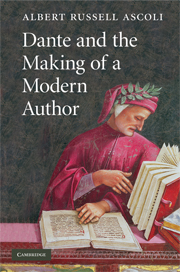Book contents
- Frontmatter
- Contents
- Preface
- Abbreviations of primary texts and translations
- INTRODUCTION
- Part 1 AN AUTHOR IN THE WORKS: DANTE BEFORE THE COMMEDIA
- Chapter 2 Definitions: The vowels of authority
- Chapter 3 Language: “Neminem ante nos”
- Chapter 4 Auto-commentary: Dividing Dante
- Part 2 AUTHORITY IN PERSON: DANTE BETWEEN MONARCHIA AND THE COMMEDIA
- Works consulted
- Index of proper names and works cited
Chapter 3 - Language: “Neminem ante nos”
Published online by Cambridge University Press: 22 September 2009
- Frontmatter
- Contents
- Preface
- Abbreviations of primary texts and translations
- INTRODUCTION
- Part 1 AN AUTHOR IN THE WORKS: DANTE BEFORE THE COMMEDIA
- Chapter 2 Definitions: The vowels of authority
- Chapter 3 Language: “Neminem ante nos”
- Chapter 4 Auto-commentary: Dividing Dante
- Part 2 AUTHORITY IN PERSON: DANTE BETWEEN MONARCHIA AND THE COMMEDIA
- Works consulted
- Index of proper names and works cited
Summary
VERNACULAR AUTHORSHIP BETWEEN CONVIVIO AND DE VULGARI ELOQUENTIA
If Dante's definitional approach to autorità in Convivio has gone virtually unexamined in the scholarship, his choice of the vernacular over Latin has not. It is widely recognized, in no small measure because Dante insists on it, that his sense of himself as author-on-the-make is intimately bound up with the problematic status of the nascent Italian language as a vehicle for serious intellectual and moral discourse, its patently inferior status with respect to the normative language of high culture in the Middle Ages.
This issue is already on the table in Vita Nova. For instance, it is visible in the interpolation of Latin tags at various strategic points throughout the text. It is a central feature of chapter 25, where the vernacular “dicitori d'amore” are both distinguished from and compared to those classical poeti – four of five writing in Latin – whom Dante dares to present as their counterparts in the deployment of figurative language. On the other hand, no overt defense of the use of Italian as against Latin is made, except in the negative sense of limiting vernacular poetry to the subject of the love for a woman, and of defining women as a crucial segment of the work's intended audience.
In Convivio the situation has changed (cf. Grayson 1963: 46).
- Type
- Chapter
- Information
- Dante and the Making of a Modern Author , pp. 130 - 174Publisher: Cambridge University PressPrint publication year: 2008

